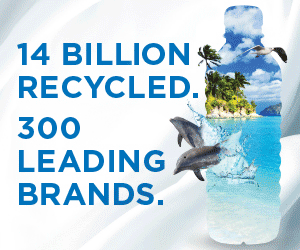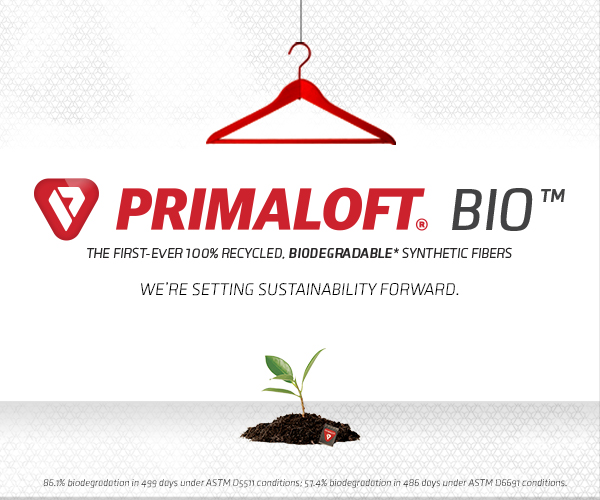New Age Performance
Realizing a Future of Sustainably-Made Functionally-Fit Textiles

The time is here for significant change in how textiles are sourced, produced and communicated to consumers.
A collective rallying cry for sustainable practices grows louder every day as news reports of climate change become frequent and the proliferation of ocean plastic pollution makes headlines. At the same time, a cultural shift toward living mindfully is underway as the wellness trend of recent years builds, giving way to lifestyles driven by socially-conscious consumerism and purposeful purchasing valued for a user-friendly approach with feel-good appeal. Yet, performance remains a priority, with versatility in functionality – be it stretch and softness or temperature regulation and smart materials – increasingly in demand as consumers now expect comfort tech in everything they wear, whether that is apparel and footwear for sport, street, or office attire.
Together these strong market trends are ushering in an era of new age performance.
“The consumer mantra now is, ‘I want to do the right thing,’” states Ellen Karp, founder and consumer strategist at Anerca International, Toronto, Canada. She explains that comments such as, “I’m committed to living a sustainably friendly lifestyle,” appear again and again in market research. Indeed, seven in 10 people globally agreed with that statement in a recent research study to assess consumer attitudes about textile sustainability that Karp conducted for Oeko-Tex Institute.
Karp identifies the “feel good factor” as an important trend. She states, “42 percent of respondents said, ‘I like to know the values and principles of brands I buy.’” An overwhelming reference to taking responsibility, about being part of the solution not part of the problem, and taking small steps to sustainability, came from survey respondents, says Karp. “Aspiration comes before action. But I can say, people are on the path, guided by their principles.”
The 10-country study of 11,000 people, commissioned by Oeko-Tex to commemorate the organization’s 25th anniversary, entitled “The Key to Confidence: Consumers and Textile Sustainability – Attitudes, Changing Behaviors, and Outlooks” was conducted over a two-year period, providing Karp with “tons of data and about 40,000 consumer quotes.” The scope and the vast scale of the study, makes it special, according to Karp, who works on sustainability and other branding issues with a wide array of the leading apparel, personal care, and luxury brands.
She cites the movement for “holistic information,” as another key takeaway from the Oeko-Tex study. “Messaging galvanizes people into action to do good, and the decision to act better intensifies,” Karp explains. Her own message to the industry is to get on top of this trend. “It becomes more essential for textile suppliers to communicate values.”
Firms are responding to this call to action. Industry execs are reporting different strategies that tap into these, and other, strong market trends. They highlight efforts ranging from transparency and green chemistry to reaching new markets with technologies designed to enhance everyday experiences. While the ways in which corporations are approaching market conditions may vary in terms of specific area of focus, a common theme exists: the realization that sustainably-made functional fit textile are the future.
“Most brands look at the first tier of the supply chain but to go deeper to tier two and three is the next step.”
– MeiLin Wan, VP textile sales, Applied DNA Sciences
Providing Proof of Supply Chain Traceability
“Lots of brands have earmarked 2020 as a big year for sustainability plans and goals. Which means 2019 is time to get ducks in a row, and be talking about what you are actually doing to achieve these goals. And that’s where we fit in,” says MeiLin Wan, VP textile sales, Applied DNA Sciences (ADNAS). “Because a lot of manufacturers and brands are now realizing ‘oh, my gosh,’ it’s not enough to say what we’re doing but we need to prove what we are doing. And they need a tool to do that.”
Today’s eco-conscious consumers are curious about raw materials and are interested in traceability – and they want to be sure that information has scientific basis. Says Wan: “The competitive landscape has changed in the last two years with more companies doing traceability.” While this is a positive, Wan believes it is not enough to solely identify place of origin; companies need to prove traceability throughout the entire supply chain. “Most brands look at the first tier of the supply chain – fabric, trim – but to go to tier two and three, that is, deeper into the supply chain, is the next step.”
ADNAS works closely with manufacturers and educates suppliers to talk to the brands. “Our mission, if you will, is to provide innovative, traceability solutions – some may be DNA, some not – to provide traceability for every textile in the world. Anyone can use our system of identity preservation.” ADNAS has gained traction in several markets including denim, home and apparel with its SigNature T tagging and testing platform for fibers – including cotton and recycled PET – throughout the value chain. Recently ADNAS has branched out and is now working on providing traceability solutions for wool and down.
Wan is optimistic that change will happen as more brands become proactive about promoting sustainability throughout the textile supply chain but she takes a realistic view of the future: “The truth is it may not be the same level of responsibility of say a Patagonia, or with the same level of intention, but other companies will do it because they have no choice. I don’t think it’s going to be driven all by the consumer; I think it will be a combination of consumer and competitive landscape driving change. And it’s going to take time.”
Offering Comfort on a Global Level
The idea of sustainability and technology going hand in hand is no longer confined to sport and outdoor product, as eco performance captures the attention of 7th Avenue brands known best for streetwear and suiting.
“It seems all categories are now looking to fabric technologies that have been vetted in the performance sport and outdoor world but can be used elsewhere,” says Christy Raedeke, EVP marketing and sales at the firm 37.5. “Customers are demanding the comfort and functionality that they have in the gear they wear for sport on the weekends in the clothing that they wear every day, and in fabrications like silk, cashmere, merino, and other natural blends. And there’s no reason they should not have that same comfort in all clothing.”
For 37.5, wool suiting and cotton dress shirts are fast growing businesses around the world. “Our suiting business has grown 177 percent from 2016 to 2018 with brands like Kenneth Cole, Carl Gross, Daniel Hechter, and others,” says Raedeke.
A suit is inherently uncomfortable, especially in hot environments, yet suits remain the preferred menswear attire for business in Japan, Europe and other international hubs. Brands, however, are recognizing 37.5 as a technology that can offer a comfort solution.
“The same technology that improves athlete efficiency by removing sweat in the vapor stage can change the comfort of garments worn during the work week.” – Christy Raedeke, EVP marketing/sales, 37.5
Raedeke also mentions 37.5’s success in Tommy Bahama’s silk shirt business, in addition to recent 37.5 launches with Banana Republic for thermo-regulation and a new global denim launch with Calvin Klein and Tommy Hilfiger. “Northern European brands want denim with warmth, while in Southeast Asia, brands want denim with cooling – 37.5 provides both.”
It’s due to the heat index factor. For example, a blind test was performed at third-party lab Inside Climate Munich with a cotton dress shirt and wool jacket with and without 37.5 technology. A test subject peddled on a bike to create heat. When the heat index was measured under the garments, the ensemble without 37.5 was 16OF/8OC hotter than under the suit system with 37.5 Technology. “This is a significant difference that is noticeable by the consumer. So the same technology that improves athlete efficiency by removing sweat in the vapor stage can change the comfort of garments worn during the work week,” Raedeke explains.
The movement of performance technology into broader markets is such that Première Vision has replaced Outdoor Retailer as trade show of choice for 37.5.
In September, Première Vision launched the Sport & Tech Forum, an entire area devoted to performance fabrics and technologies that showcase “the growing importance of the combination of technical fabrics and sportswear codes in tomorrow’s fashions.”
Raedeke says she was recently in India where despite the extreme heat, women wear saris. Saris made with 37.5 technology are now an area of interest. Says Raedeke, “You can’t be myopic and just look at the outdoor industry – from sleep, to saris and from silk to tailored suits, people want comfort. These days the ultimate luxury is comfort.”
“Since we were part of Clariant, we have seen a competitive advantage to focus on sustainability.”
– Steve Richardson, brand marketing, Archroma
Chemistry as Change Maker
As people start to consume less, and adopt a purchasing pattern of buying fewer but better quality clothes, brands are using words like “long-lasting” and “guaranteed” to express a good investment. “If you have fewer items they need to deliver more, whether that is functionally or style,” explains Karp who refers to this as “curated acquisition.” Interestingly this cultural trend has a direct link to green chemistry, which Karp, and others, believe is an area to watch.
Nowadays brands are coming to suppliers with specific technology in mind and consumers want products that bring benefits so that if they buy an expensive t-shirt it will hold its color and the textile will last longer. These attitudes are creating a modern approach to how chemistry is sold that prioritizes performance and reducing impacts with cleaner, greener processes.
“Chemistry is where material innovation is happening, and making a difference in the end product,” says Steve Richardson, brand marketing, Archroma. He explains that chemistry is playing a more integral role in product development with brands nominating specific chemistry – both in terms of functionality but also color. For instance, brands may want a nylon/taffeta with a very specific PFC-free finish, explains Richardson. “That wouldn’t have happened in the past, but that’s where the innovation will occur.”
“We no longer live in an ingredient innocent world. The way people look at the side of cereal box, they should look at the label in their shirt.” – Ellen Karp, founder, Anerca International
Archroma is a global color and specialty chemicals company, with U.S. operations in North Carolina. The company formed in October 2013 when spun off from the textile, paper and emulsions businesses of Clariant. However, promoting sustainable solutions and innovating products and processes, such as Advanced Denim water-savings technology and the One Way tool were in place before the transition. “Since we were part of Clariant, we have seen a competitive advantage to focus on sustainability,” states Richardson.
Archroma processes are designed to help textile mills lower impacts and provide savings in production time and costs. A new systems approach takes this to the next level.
Instead of selling a mill a black dye or a scouring agent, for instance, a “systems of chemistry” is more effective in terms of potential savings in water and/or energy and importantly also gives mills the ability to sell the textile at a higher value.
Archroma’s One-Way Tool calculates one cycle of impacts of chemistry within a textile mill and provides a snapshot of the economic value of Archroma chemistry systems.
For mills a big carrot is time. Richardson adds, “If a mill can reduce production time by 20 percent they can get an extra lot done everyday. That is huge in terms of time and cost saving.”
Brands come to Archroma because they have a problem that needs to be solved, explains Richardson, whose background includes work in materials development, sustainability and innovation with Patagonia, adidas and Tesla. He cites EarthColors, a range of traceable dyes based agricultural and herbal waste, Smartrepel, fluorine-free water repellents, and its new aniline-free Denisol Pure Indigo, as examples of Archroma’s market responsiveness. (See Denim story on page 19 for details.)
“We do know that consumers respond to options, and buy ‘what is better for them,’” says Richardson. “We see this in food and other lifestyle choices, and the same is true in apparel content.”
It’s all about raising people’s knowledge about the industry. “People react when they are educated,” says Karp. “This has to come from the ingredient people. These companies have to start the chain of education in the industry. Communication is key and has to be done in a way that the brands can use the information to relate to consumer,” Karp adds. “We no longer live in an ingredient innocent world. The way people look at the side of cereal box, they should look at the label in their shirt.”







